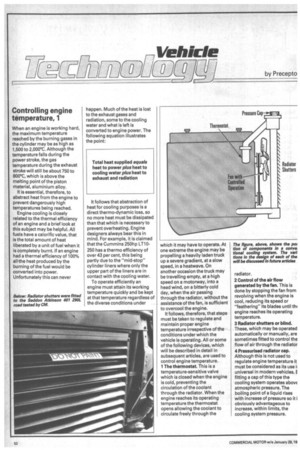Controlling engine temperature, 1
Page 54

If you've noticed an error in this article please click here to report it so we can fix it.
When an engine is working hard, the maximum temperature reached by the burning gases in the cylinder may be as high as 1,500 to 2,000°C. Although the temperature falls during the power stroke, the gas temperature during the exhaust stroke will still be about 750 to 800°C, which is above the melting point of the piston material, aluminium alloy.
It is essential, therefore, to abstract heat from the engine to prevent dangerously high temperatures being reached.
Engine cooling is closely related to the thermal efficiency of an engine and a brief look at this subject may be helpful. All fuels have a calorific value, that is the total amount of heat liberated by a unit of fuel when it is completely burnt. If an engine had a thermal efficiency of 100% all.the heat produced by the burning of the fuel would be converted into power. Unfortunately this can never happen. Much of the heat is lost to the exhaust gases and radiation, some to the cooling water and what is left is converted to engine power. The following equation illustrates the point: It follows that abstraction of heat for cooling purposes is a direct thermo-dynamic loss, so no more heat must be dissipated than that which is necessary to prevent overheating. Engine designers always bear this in mind. For example, it is claimed that the Cummins 250hp LT10250 has a thermo efficiency of over 43 per cent, this being partly due to the "mid-stop" cylinder liners where only the upper part of the liners are in contact with the cooling water.
To operate efficiently an engine must attain its working temperature quickly and be kept at that temperature regardless of the diverse conditions under which it may have to operate. At one extreme the engine may be propelling a heavily laden truck up a severe gradient, at a slow speed, in a heatwave. On another occasion the truck may be travelling empty, at a high speed on a motorway, into a head wind, on a bitterly cold day, when the air passing through the radiator, without the assistance of the fan, is sufficient to overcool the engine.
It follows, therefore, that steps must be taken to regulate and maintain proper engine temperature irrespective of the conditions under which the vehicle is operating. All or some of the following devices, which will be described in detail in subsequent articles, are used to control engine temperature. 1 The thermostat. This is a temperature-sensitive valve which is closed when the engine is cold, preventing the circulation of the coolant through the radiator. When the engine reaches its operating temperature the thermostat opens allowing the coolant to circulate freely through the radiator.
2 Control of the air flow generated by the fan. This is done by stopping the fan from revolving when the engine is cool, reducing its speed or "feathering" its blades until thi engine reaches its operating temperature.
3 Radiator shutters or blind. These, which may be operated automatically or manually, are sometimes fitted to control the flow of air through the radiator 4 Pressurised radiator cap. Although this is not used to regulate engine temperature it must be considered as its use universal in modern vehicles. E fitting a cap of this type the cooling system operates abovE atmospheric pressure. The boiling point of a liquid rises with increase of pressure so it i obviously advantageous to increase, within limits, the cooling system pressure.




















































































